Civil & Environmental Engineering
Faults & Fluid Flow
Faults and fluid flow (FAFF) is a research collaboration led by Prof. Zoe Shipton and Prof. Becky Lunn in the Department of Civil Engineering at the University of Strathclyde. FAFF is a multidisciplinary group of researchers with expertise including:
- Field characterisation of fault zone architectures
- Numerical modelling of hydro-mechanical fault zone development
- Statistical characterisation of fluid flow through fault zones
Our aim is to use a range of tools to:
- Predict the mechanical and petrophysical properties of fault zones in the subsurface
- Understand the large-scale controls on fault architectural properties
- Statistically characterise both small and large-scale variability of fault zone architectures
- Numerically simulate spatial and temporal evolution of fault damage zones
- Constrain the role of fault-controlled fluid flow on the thermal and chemical structure of the shallow crust
- Understand and constrain uncertainty in geological models.
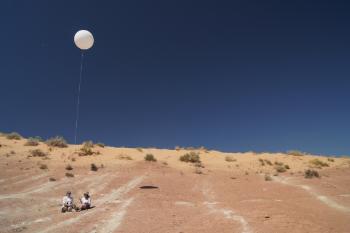
Members of FAFF at the Moab fault in Utah, piloting a novel means of mapping fault architecture using a helium balloon.
Our research projects
Modelling spatial & temporal fault zone evolution
There's considerable industrial interest in assessing the permeability of faults for the purpose of oil and gas production, deep well injection of waste liquids, underground storage of natural gas and disposal of radioactive waste. Prior estimation of fault hydraulic properties is highly error prone.
Faults zones are formed through a complex interaction of mechanical, hydraulic and chemical processes and their permeability varies considerably over both space and time. Algorithms for predicting fault seal potential using throw and host rock property data exist for clay-rich fault seals but are contentious. In the case of crystalline rocks and sand-sand contacts, no such algorithms exist.
In any case, the study of fault growth processes does not suggest that there is a clear or simple relationship between fault throw and the fault zone permeability. To improve estimates of fault zone permeability, it’s important to understand the underlying hydro-mechanical processes of fault zone formation.
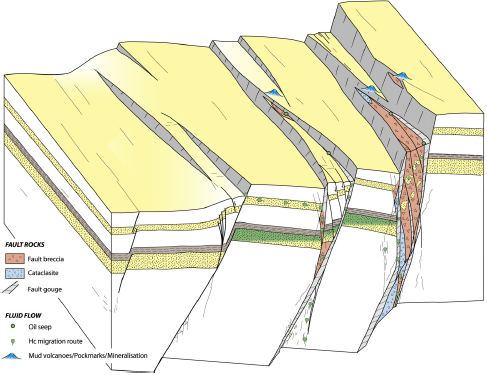
Left to right evolution of individually nucleating faults to a large, complex fault zone Wibberley & Shipton (2010)
In this research, we explore the spatial and temporal evolution of fault zones through development and application of a 2D hydro-mechanical finite element model (MOPEDZ). The development of fault zone damage is simulated perpendicular to the main slip surface using a fully coupled solution of Navier's equation for mechanical deformation and Darcy's Law/conservation of fluid mass for subsurface fluid flow. MOPEDZ is applied to study development of fault zones in basement rocks, based on the conceptual model of Martel (1990). We simulate the evolution of fault zones from pre-existing joints and explore controls on the growth rate and locations of multiple splay fractures which link-up to form complex damage zones.
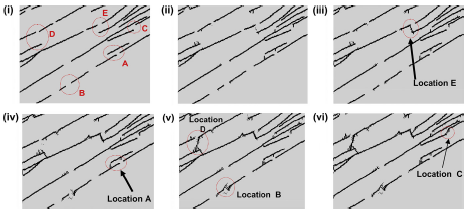
Temporal evolution of linking fractures, modelled using MOPEDZ (Moir, et al., 2010)
We’re the first researchers to successfully simulate:
- the temporal and spatial evolution of multiple wing cracks
- tertiary fracturing
- antithetic fractures propagating into the compressive region
- infill fracturing between faults and joints
- the temporal development of simple fault zones from pre-existing joint patterns
- hydrofracturing during thermal pressurisation
Results from these simulations have been validated using outcrop data and research is now in progress to up-scale our results for determination of statistical parameters describing larger scale spatial permeability structure in faults.
Related publications
- Moir, H., Lunn, R.J., Shipton, Z.K., and Kirkpatrick, J.D. (2010). Simulating Brittle Fault Evolution from Multiple Pre-existing Structures: The Importance of Stress Interactions. Journal of Structural Geology. doi:10.1016/j.jsg.2009.08.016.
- Lunn R.J., Willson J.P.,Shipton Z.K.andMoir H.(2008). Simulating brittle fault growth from pre-existing structures. Journal of Geophysical Research. doi:10.1029/2007JB005388
- Willson J.P.,Lunn R.J., andShipton Z.K.(2007). Simulating spatial and temporal evolution of multiple wing cracks around faults in crystalline basement rocks, Journal of Geophysical Research, 112, B08408, doi: 10.1029/2006JB004815.
Simultaneous evolution of seismicity & permeability
Characterising the permeability of faults is critical for effective underground disposal of radioactive waste, storage of natural gas, deep well injection of waste liquids (including CO2) and hydrocarbon production.
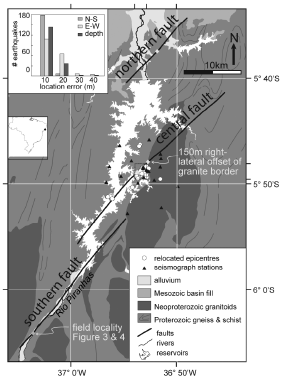
Currently industry estimates of fault permeability frequently range over several orders of magnitude for a single site and represent one of the greatest sources of uncertainty in risk assessments. The permeability of faults is governed by complex fully-coupled relationships between seismic (or aseismic) slip events, the fluid pressure field, mechanical properties of the host rock, and the geochemical environment. Quantification of these relationships and their effect on the temporal evolution of permeability has never been validated at the field scale.
Recent observations of microseismic activity beneath the Açu water reservoir in NE Brazil (above) provides an unprecedented insight into these processes and a basis for quantifying their inter-relationships. The earthquakes can be accurately located, they occur frequently on three well-monitored faults and there is a clear causal link with pressure diffusion from a well-monitored source.
The main aim of this research is to analyse these in combination with field studies of exhumed seismogenic faults and numerical hydro-mechanical modelling. This will allow us to develop the first field evidence-based conceptual and numerical models of simultaneous seismicity and permeability evolution in faults.
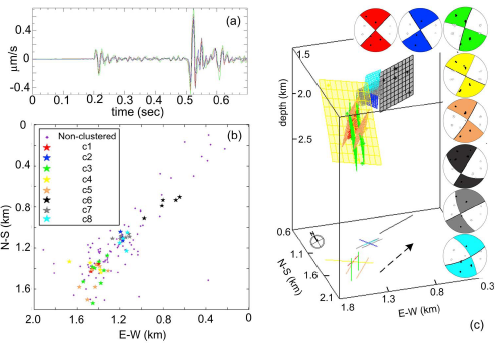
Seismic data analysis. (a) Stacked waveforms for cluster C1 (b) Plan view of relocated epicentres in the highlighted area from top figure (c) Best fit planes of clusters C1 to C8. (Pytharouli, et al. 2011)
There are five specific objectives of the research:
- Detailed analysis of the seismicity data to determine earthquake locations with improved accuracy, calculate rupture dimensions, and constrain recovery of mechanical strength and energy losses.
- Integration of the results from objective 1 with the current mathematical understanding of hydro-mechanical coupling in seismically active faults to test existing theory and develop new conceptual models. These conceptual models will examine relationships between zones of increased permeability, rupture dimensions, spatial and temporal permeability change and mechanical healing.
- Numerical simulation using Prof Lunn's hydro-mechanical model, MOPEDZ, to predict seismic triggering and simultaneous permeability evolution within a seismically active fault beneath Açu. Comparing these predictions with observation data from objective 1 will allow elimination of conceptual models that are inconsistent with the data.
- Validation of MOPEDZ using field data from fault damage zones developed in anisotropic crystalline rocks near Açu (previous validation has only been on isotropic crystalline and sedimentary rocks). The field data and lessons learnt during validation of MOPEDZ will provide additional constraints on the modelling in objective 3.
- Validation of the conceptual models developed and constrained in objectives 2 & 3 using data from two other seismically active faults beneath Açu Reservoir. This will test the applicability of the models to other faults.
Related publications
- Pytharouli, S.,Lunn, R.J.,Shipton, Z.K.,Kirkpatrick, J.D. & Nascimento, A.F., 2011Microseismicity illuminates open fractures in the shallow crust.Geophysical Research Letters Vol 38, pp. L02402http://dx.doi.org/10.1029/2010GL045875
- Nascimento A.F.,Lunn R.J., Cowie P., 2005Numerical modelling of pore-pressure diffusion in a reservoir-induced seismicity site in northeast Brazil.Geophysical Journal International Vol 160, No. 1, pp. 249-262http://dx.doi.org/10.1111/j.1365-246X.2005.02473.x
- Nascimento A.F.,Lunn R.J., Cowie P., 2005Modeling the heterogeneous hydraulic properties of faults using constraints from reservoir-induced seismicity.Journal of Geophysical Research Atmospheres Vol 110, No. B09201,http://dx.doi.org/10.1029/2004JB003398
- Nascimento A.F., Cowie P.A.,Lunn R.J.Pearce R.G., 2004Spatio-temporal evolution of induced seismicity at Acu Reservoir, NE Brazil.Geophysical Journal International Vol 158, No. 3, pp. 1041-1052
http://dx.doi.org/10.1111/j.1365-246X.2004.02351.x
Sandstone deformation band fault properties
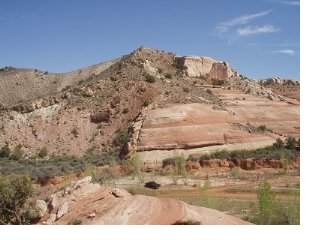
Predicting the sealing potential of faults such as the Moab fault, Utah (pictured)is dependent on having detailed structural and petrophysical data on the character of the fault. Deformation band fault core has only recently been recognised as a distinct component of deformation band faults.
Deformation bands are the main structural element in high porosity rocks. Deformation band faults were previously divided into single deformation bands, zones of deformation bands and slip surfaces (Aydin, 1978). Shipton and Cowie (2001) recognised that in outcrops a fault core of particularly fine-grained material is always found in association with through-going slip surfaces.
Aileen Bright's PhD research (funded by Enterprise Ireland) provided insights into the character, growth and sealing potential of faults in porous reservoir sandstones. The initial focus of the research was to describe the multiple components in the fault core of deformation band faults. Three previously unrecognised fault core components were described in detail: condensed deformation bands, minor slip surfaces and breccia. Petrophysical data (permeability and porosity) were collected to characterise each of the fault core components. Aileen then examined a range of fault growth stages from field sites in a wide range of host rock types and with a range of offsets (field areas in Permian and Jurassic aeolian and fluvial sandstones in Utah, Scotland and northern England).
The field studies allowed us to place new constraints on the timing and conditions of slip surface nucleation and fault core development with increasing offset (growth). Deformation band fault core is shown to be a potential conduit and/or barrier to fluid flow at different points along strike and under different conditions (e.g. fluid pressure, stress). Potential along-fault conduits are major slip surfaces (if open). Potential across fault conduits include breccia pods, joints, interconnected slip surfaces and fractures.
One of the most important parameters in upscaling bulk fault zone properties is the thickness of the low porosity andpermeability fault core. As part of Aileen's studies she collected new data that showed that fault core thickness, which show that the fault core thickness is spatially correlated. This kind of statistical characterisation may allow better upscaling of fault zone properties in the future.
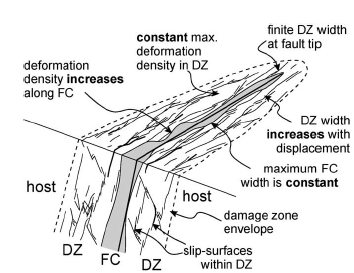
Related publications
- Fossen H., Schultz R.A.,Shipton, Z.K.and Mair K. 2007. Deformation bands in sandstone - a review. Journal of the Geological Society, 164, 755-769.
- Shipton, Z.K.and Cowie, P.A. 2003. A conceptual model for the origin of fault damage zone structures in high-porosity sandstone. Journal of Structural Geology, 25, 333-345. Doi: 10.1016/S0191-8141(02)00037-8.
- Shipton, Z.K., Evans, J. P., Robeson, K., Forster, C. B. and Snelgrove, S. 2002. Structural heterogeneity and permeability in faulted eolian sandstone: implications for subsurface modelling of faults. American Association of Petroleum Geologists Bulletin, 86, 863-883.
- Shipton, Z.K.and Cowie P.A. 2001. Damage zone and slip-surface evolution over micron to km scales in high-porosity Navajo sandstone, Utah. Journal of Structural Geology. 23, 1825-1844. doi: 10.1016/S0191-8141(01)00035-9.
Natural leaking carbon dioxide (CO2)
Analysis of leaky CO2reservoirs in the northern Paradox Basin, Utah, has allowed us to develop a model for the shallow subsurface flow of CO2. The results provide information on how CO2migrates and reacts with groundwater and reservoir rocks in the subsurface, and what the effects on surface environments are when CO2leaks to the surface.
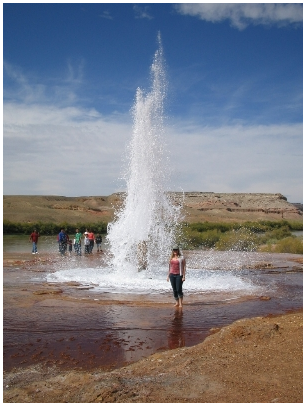
A series of shallow fluvial and aeolian sandstone groundwater reservoirs are charged with CO2 which builds up in a north-plunging anticlinal trap with fault sealing on its southern margin. Top seal is provided by shale-rich formations, but fractures related to the fault damage zone provide conduits through the top seal. This geometry has resulted in a series of stacked reservoirs, and ultimately in escape of the natural CO2into the atmosphere. The CO2escapes through a series of springs and geysers along the faults, and through wellbores that have penetrated the reservoir. At the surface, rapid degassing of CO2 -charged groundwater results in the formation of travertine mounds around active springs. The presence of deeply incised ancient mounds attests to the long lifespan of this leaky system. There is no evidence of adverse effects of this leakage on wildlife or humans, and the springs provide (somewhat saline) water for plants in this high desert environment.
Studies on the effect of long-term leakage both in the subsurface and at the point of leakage to the surface provide data on factors that affect the safety and feasibility of future CO2injection projects. This should guide the design and implementation of geologic sequestration projects. This work formed the PhD ofBen Dockrill(2006, Trinity College, Dublin) and the masters projects of Jason Heath and Tony Williams (Utah State University). Ongoing research in this area is being conducted byNeil BurnsideandStuart Gilfillan.
Related Publications
- Kampman Niko, Burnside Neil M.,Shipton Zoe K., Chapman Hazel J., Nicholl Joe A., Ellam Rob M., Bickle Mike J. (2012). Pulses of carbon dioxide emissions from intracrustal faults following climatic warming, Nature Geoscience Vol 5, No. 5, pp. 352–358. doi.org/10.1038/NGEO1451.
- Gilfillan Stuart M V, Wilkinson Mark, Haszeldine R. Stuart,Shipton Zoe K., Nelson Steven T, Poreda Robert J. (2011).He and Ne as tracers of natural CO2migration up a fault from a deep reservoir, International Journal of Greenhouse Gas Control, Vol 5, No. 6, pp. 1507–1516. doi.org/10.1016/j.ijggc.2011.08.008
- Dockrill B.andShipton, Z.K.(2010). Structural controls on leakage from a natural CO2geologic storage site: central Utah, U.S.A. Journal of Structural Geology, in press. doi:10.1016/j.jsg.2010.01.007.
- Shipton, Z.K., Evans, J. P.,Dockrill B., Heath J., Williams A., Kirchner D. and Kolesar P. T. (2005). Natural leaking CO2-charged systems as analogs for failed geologic sequestration reservoirs. In: Thomas D. and Benson S.M (Eds). Carbon Dioxide Capture for Storage in Deep Geologic Formations; Results from the CO2Capture Project, Volume 2. Elsevier Science. p. 699-712.
- Shipton, Z.K.and Evans, J.P. and Kirchner, D. and Kolesar, P.T. and Williams, A.P. and Heath, J. (2004). Analysis of CO2leakage through "low-permeability" faults from natural reservoirs in the Colorado Plateau, southern Utah. In Baines, S.J. and Worden, R.H. (Eds) Geological storage of carbon dioxide. Geological Society, London, Special Publications, no.233, p.43-58.
Thermal effects of fluid flow in orogenic belts
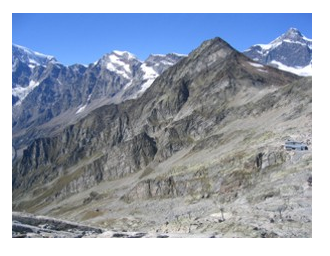
Whilst geothermal gradients are relatively well constrained in sedimentary basins, it’s often assumed that due to the perceived low porosity and permeability of crystalline basement, fluid movements have little influence on the thermal structure of much of the shallow crust.
Dempster and Persano (2006) have demonstrated that virtually all the published thermal histories of cooling orogenic belts show patterns consistent with exceptionally low temperature geothermal gradients in the upper parts of the crust. This is interpreted as the shallow crust having much more rapid rates of heat transfer reflecting efficient heat transport by fluids. “Crystalline basement” should no longer be thought of as “impermeable basement”.
Current projects (funded by the Carnegie Trust, NERC and the Royal Society) are using low temperature thermochronology to investigate fluid flow in two principal scales.
Firstly, on the scale of individual mountains we’re analysing vertical profiles of samples to attempt to constrain for the first time in detail palaeogeothermal gradients in an orogenic belt. Secondly, we’re investigating individual conduits for fluids in detail to study both the thermal influence of any fluid movement and the effect on the geochemistry, mineralogy and isotope geochemistry of the host lithologies.
These studies are being undertaken in the granitic basement lithologies of the Monte Rosa (pictured)and Mont Blanc massifs. In both places prominent fracture systems showing abundant petrological evidence of fluid flow are combined with superb levels of exposure and vertical relief in excess of 2000m allows for the collection of vertical profiles. The detailed relationships between movements on these fracture systems and the petrological effects of fluid flow are being investigated by Susan Lawther as part of her PhD research.
Related publications
- Dempster T. J., Martin J.C.,Shipton Zoe. (2008). Zircon dissolution in a ductile shear zone, Monte Rosa granite gneiss, northern Italy, Mineralogical Magazine, Vol 72, No. 4, pp. 971-986.doi.org/10.1180/minmag.2008.072.4.971
- Dempster, T.J. and Persano, C. (2006). Low temperature thermochronology: Resolving geotherm shapes or denudation histories? Geology, v.34, 73-76.